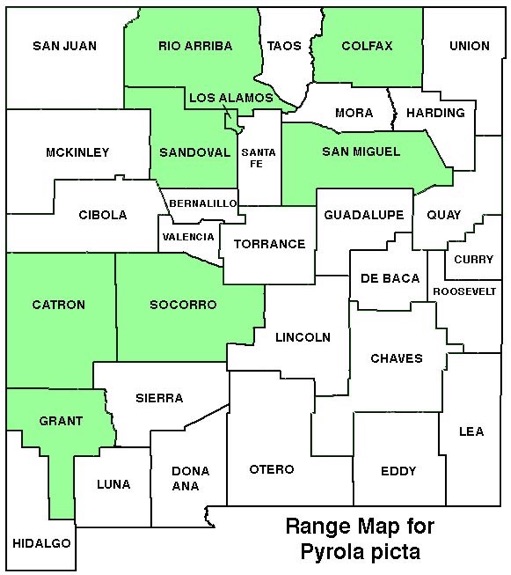WILDFLOWERS OF NEW MEXICO

With 2 3/8–12 inch tall, leafless stems (scapes) lined with small, creamy-white flowers, this dainty plant spreads by rhizomes and forms small colonies on shaded forest floors. Note the crowded basal leaves are distinctively lined with white veins.
FLOWER: June–September. Flower stem lined with spike-like cluster (raceme) of 4–10 creamy to pale-green flowers, 3/8 inch wide (1 cm); flowers nod like inverted cups, 5 petals, 10 stamens, and an elongated, curved style that protrudes beyond the petals.
LEAVES: Basal, leaf stalk (petiole) 3/8–1 3/4 inches long (1–4.5 cm). Blades oval to elliptic, 1–3 inches long (2.5–7.5 cm); surfaces green, mottled with white along the veins; margins entire or with minute, rounded teeth.
HABITAT: Sandy, gravelly, clay-loam soils of mixed conifer forests; ponderosa-aspen, spruce fir forests.
ELEVATION: 7,900–10,200 feet.
RANGE: All states west of Rocky Mts.
SIMILAR SPECIES: Green-flowered Wintergreen, Pyrola chlorantha, in much the same range, has pale, creamy green leaves. Sidebells Wintergreen, Orthilia secunda, in the northern, central, and western mountains in NM, has clusters of bell-shaped flowers along one side the stem, and leaves on the lower 1/3 of the stem.
NM COUNTIES: Northern and sw mountains of NM in mid- to high-elevation, forested habitats: Catron, Colfax, Grant, Los Alamos, Sierra, Rio Arriba, San Miguel, Sandoval.









WHITE-VEIN WINTERGREEN
PYROLA PICTA
Heath Family, Ericaceae
Perennial herb


















THE CONTENTS OF THIS WEBSITE ARE COPYRIGHTED AND CANNOT BE USED
WITHOUT PERMISSION OF GEORGE OXFORD MILLER
















EMAIL ME


















The style elongates beyond the petals and has a slight curve.

The flower stalk (scape) has 4–10 creamy to pale-green, inverted flowers.









Basal leaves are variegated with white main and radiating veins. Stems are often reddish.
















